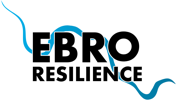The Walking Rivers global experience reached the middle stretch of the Ebro River through our LIFE Ebro Resilience P1 project. On May 11, we went out into the field along with nearly 100 other proposals on five continents, to walk along the river to learn and enjoy. In our case we completed a 7 km route between the meanders of El Señorío (Castejón, Navarra) and La Roza (Alfaro, La Rioja).
Walking Rivers
is an initiative organized by the Iberian Center for River Restoration (CIREF); Wetlands International; the LIFE program; the Walking the Water project and the Botín Foundation and its objective is to raise awareness of river courses from the local to the international level.
LIFE Ebro Resilience P1 would like to thank many people for their participation in this conference, in which we talked about the Ebro, the copses and meadows, but also, of course, about the phenomenon of flooding and the actions implemented and proposed in this Project to reduce the risk in the middle section (recovery of river space, river restoration and adaptation).


For the diffusion we had the support of the City Councils of Castejón and Alfaro, and other surrounding municipalities that also echoed, attracting groups of family and friends.
In addition, in the river we also show one of the keys to this project, the coordination of the Administrations. Technical colleagues from the Government of La Rioja, Environmental Management of Navarra (GAN-NIK), the Ebro Hydrographic Confederation (CHE – MITECO) and the public company TRAGSATEC, explained what we can find and enjoy in the groves and what Ebro Resilience does to reduce the risk of flooding.

El Señorío – La Roza
The route is included in the intervention zone 1 of the LIFE Ebro Resilience P1 project, in what is called the combined section between Alfaro, La Rioja and Castejón, Navarra, in the combined section that includes various proposals such as the reconnection of meanders, relief channels, recovery of old river branches and expansion of the river space.
This intervention will have a positive effect on more than 500 hectares of agricultural land, reducing the risk of flooding and allowing the recovery of 60 hectares of river space.
The proposal consists of the sum of shares such as the reconnection of meanders, the creation of relief channels, the recovery of old river branches and the enlargement of the river space, together, offer an overall benefit with respect to flood risk and the environmental condition of the river.measurable at section level.
But what are the interventions? Those defined in the LIFE Ebro Resilience P1 Project are as follows:
- Soto de Alfaro (or Soto de Tamarigal): action planned for 2024 for the recovery of river branches.
- Morphological adaptation of the meander of La Roza, in Alfaro, La Rioja, executed in the absence of environmental restoration and planting, which includes the recovery of 22 hectares of river space and has involved a defense setback, the creation of a relief channel and a wetland. In addition, the hydraulic capacity of the railroad bridge has been improved in this section.
- Morphological adaptation of the El Señorío meander, in Castejón, Navarra, also scheduled for 2024, where 23 hectares of river space will be recovered by recessing defenses and creating a diversion channel.

